 Almost every human cell has a little known structure called the primary cilium. It is similar to the well known motile cilia, but without special structures for movement. This solitary, unmoving structure, most often sticking out of cells, was considered a vestigial organ. While first noted in 1987, only recently has the primary cilium been proven to have very important sensory functions—an antenna receiving information about events external to the cell. More recently it has been found to be critical for cellular communication and signaling in fetal development of all cells, but particularly brain cells. Specialized versions of the primary cilium appear in key places for sensation, such as receptors for hearing, sight and smell. Recently, a close link was found to the all-important centriole spindle that directs all cell division. Equally unusual is the discovery of a very complex
Almost every human cell has a little known structure called the primary cilium. It is similar to the well known motile cilia, but without special structures for movement. This solitary, unmoving structure, most often sticking out of cells, was considered a vestigial organ. While first noted in 1987, only recently has the primary cilium been proven to have very important sensory functions—an antenna receiving information about events external to the cell. More recently it has been found to be critical for cellular communication and signaling in fetal development of all cells, but particularly brain cells. Specialized versions of the primary cilium appear in key places for sensation, such as receptors for hearing, sight and smell. Recently, a close link was found to the all-important centriole spindle that directs all cell division. Equally unusual is the discovery of a very complex 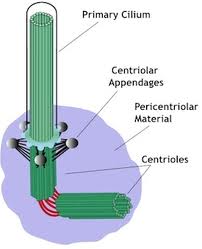 unique transport system within the primary cilium, whose defects now account for many important diseases. Is the primary cilium a cell’s antenna or its brain?
unique transport system within the primary cilium, whose defects now account for many important diseases. Is the primary cilium a cell’s antenna or its brain?
Ninety nine percent of mammal cells have a protrusion of the outer membrane, called the primary cilium. This includes all neurons and glial cells. Unlike other cilia, it is not an organ for movement. Abnormalities in the primary cilium cause retinitis pigmentosa, hydrocephalus, polycystic kidney disease, malformations of the skeleton, defects of the neural tube and some obesity.
Cilia and Flagella
Cellular protrusions or tails have been called flagella and cilia. Flagella are long and cilia are short. Flagella and mobile cilia have the same structure designed for movement with cross connections between 9 primary microtubules. The primary cilium does not have the  connections for movement. When flagella are present in a cell, there is a small number—less than 5. There can be over a hundred cilia in rows.
connections for movement. When flagella are present in a cell, there is a small number—less than 5. There can be over a hundred cilia in rows.
Sperm cells are mostly a tail that moves; it is a very long flagella. Some cells have rows of many cilia that often function in a synchronized movement. Cells that line the surface of the lungs and respiratory passages have 200 cilia all moving and beating using a complex swimming motion with a stroke for power and then one for recovery. These cilia move water and mucous along the tubes. In the ear hair cells have  many cilia that pick up pressure and sound. Cilia propel fluid in the CSF to circulate in the ventricles through pores to spinal cord, brain stem, cerebellum and cortex.
many cilia that pick up pressure and sound. Cilia propel fluid in the CSF to circulate in the ventricles through pores to spinal cord, brain stem, cerebellum and cortex.
The structure in all cilia and flagella is a cylinder, with the outer shape made of nine microtubules and a membrane around it. The mobile cilia and flagella have two more microtubules in the middle and have connecting radial molecules between the microtubules that move and create movement. The primary cilium does not have the middle microtubules.
Bacterial cilia and flagella have many different structures compared with the one structure in all eukaryote cell. Each 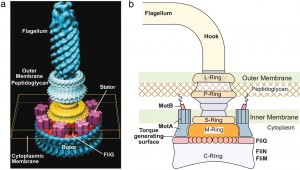 bacterial species has many different structures, with widely varying proteins.
bacterial species has many different structures, with widely varying proteins.
All bacterial flagella work differently than the tails of animal and human cells. Bacteria have rotating flagella like propellers—turning three to fifteen times per second. With this propeller machinery, they move very rapidly—up to 50 cell lengths per second.
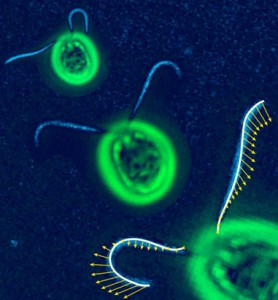 Swimming algae synchronize their two large flagella making a movement like a breaststroke. In order to maintain synchronization, the algae rocks, which speeds up or slows down the movement. While it appears to be simple, this movement involves ten thousand complex molecular machines working together.
Swimming algae synchronize their two large flagella making a movement like a breaststroke. In order to maintain synchronization, the algae rocks, which speeds up or slows down the movement. While it appears to be simple, this movement involves ten thousand complex molecular machines working together.
The Primary Cilium – PI
For a hundred years it was thought that the beating movement was the main function of cells’ tails. Recently they are noted to be antenna with sensory machinery.
With no center microtubules, the PI is a unique environment 1/10,000th the size of the cell. Because it is a circumscribed small area with a very specific diameter, unusual  proteins can anchor there and perform unique functions. There are many different sensory receptors in the membrane responding to the environment, tracking mechanical and chemical forces and sending signals to the organism. Some properties of the membrane are unique in the primary cilium. Because it is separate from the rest of the cell, special proteins can accumulate 100 times more than other places and make the signaling much more efficient.
proteins can anchor there and perform unique functions. There are many different sensory receptors in the membrane responding to the environment, tracking mechanical and chemical forces and sending signals to the organism. Some properties of the membrane are unique in the primary cilium. Because it is separate from the rest of the cell, special proteins can accumulate 100 times more than other places and make the signaling much more efficient.
The single, non-beating primary cilia has many different receptors and very important functions. In the kidneys the PI responds to the flow of the liquid through tubules. Bending from the pressure triggers calcium signaling and is part of critical kidney regulation. The first major discovery showing the capacities of PI was in polycystic kidney disease, which is caused by two abnormal proteins in the PI.
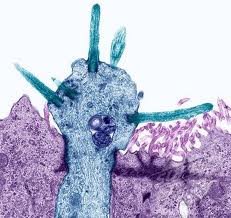 PI are now known to sense different chemicals, concentrations of ions, temperature and gravity. In the nose the olfactory receptors are in primary cilium. In the ear, cilia sense vibrations. In the eye the light sensing receptor is an outpouching at the tip of the PI. The PI senses light wavelengths in eye cells, pressure in cartilage, and blood flow in heart cells.
PI are now known to sense different chemicals, concentrations of ions, temperature and gravity. In the nose the olfactory receptors are in primary cilium. In the ear, cilia sense vibrations. In the eye the light sensing receptor is an outpouching at the tip of the PI. The PI senses light wavelengths in eye cells, pressure in cartilage, and blood flow in heart cells.
Although it was thought that mobile cilia were present in many cells, in fact, more cells have non mobile primary cilium.
In Neurons

An important recent study shows that blocking receptors on the primary cilium in mice causes memory loss. A protein (PQBP1) was identified that if absent eliminates the PI in neurons causing problems with memory and learning. PQBP1 is usually found only in the cell’s nucleus, but in the neuron it is in the base of the primary cilium. PQBP1 appears to bind to another protein that normally would suppress the cilium. It stops the suppression, allowing the creation of the PI in the neuron.
PI has also been shown to be critical for fetal brain development. Moving cilia are critical to migration of neurons and glia in developing brain. But, the non-moving PI is involved in communication with other cells during these migrations.
In the hippocampus, where new brain cells originate in adults (neurogenesis), PIs are necessary for stem cells making new neurons. When receptors in the PI respond to the external environment of the cell, receptors activate cascades that communicate to the cell nucleus using special transport motors. Without the PI in neurons during development, several brain diseases occur.
Transport System
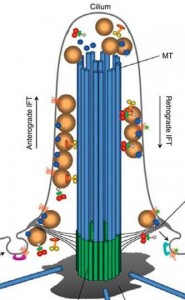 In 1993 the intra-flagella transport system IFT in the PI was observed and connected to polycystic kidney disease. It was observed that the microtubule structure, called axoneme, grows from the base of the PI, called the basal body. When the cilium is being built, vesicles transport protein pieces to the growing cilium from the base.
In 1993 the intra-flagella transport system IFT in the PI was observed and connected to polycystic kidney disease. It was observed that the microtubule structure, called axoneme, grows from the base of the PI, called the basal body. When the cilium is being built, vesicles transport protein pieces to the growing cilium from the base.
Recently, the complexity of the transport system has been described. A special protein attaches and drags proteins through the sea of phospholipids in the membrane, and pulls them into the PI. In this way the primary cilium becomes the communication hub of the cell. Already a number of critical signaling cascades have been shown to live in the primary cilium. This includes the critical hedgehog and retinal signaling pathways.
The transport system uses motors that travel along microtubules to get the important material to the tip of the PI from the base. Special motors are built at the base of the PI and they pull many different types of material into the PI—receptor proteins and building blocks for microtubules. Once at the tip of the PI, the motors deposit the cargo. At the tip 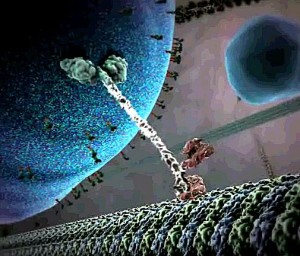 the motor is altered and becomes a different machine to bring signaling material down the PI to the base. At the based messages are created and sent to the nucleus.
the motor is altered and becomes a different machine to bring signaling material down the PI to the base. At the based messages are created and sent to the nucleus.
Once at the base of the PI, the motor rearranges itself and becomes the train that drives cargo up into the PI. The train that pulls this material to the tip of the PI is made of at least four motors, one type active at a time. These motors are not just motors; they also interact with the membrane to regulate other functions including sensing extracellular situations and influencing decisions during fetal development. These motors are also able to connect through the membrane to objects outside of the cell to stimulate different types of cell movement. In this situation the motor is anchored to a 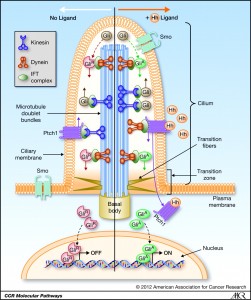 particular spot, but the entire cell moves when the motor is turned on.
particular spot, but the entire cell moves when the motor is turned on.
This very complex motor system is critical for the elaborate function of the PI by transporting all receptors and signaling materials that are used for the antenna function.
Defects in these motors in the eye can cause blindness. In the cells of the eye, the tip of the PI is very large bulb and houses the sensors that respond to light but still has a narrow area connecting with the large cell body. All of the light signals have to go through this narrow tube and a defect leads to blindness. Proteins used for sensing light are fragile and very active and many are imperfect. The cell is very dependent on the transport system of the PI to continually restock the proteins. Retinitis pigmentosa is one of the many diseases (ciliopathies) related to defects in this transport system.
Cilia Disease
New research shows that ciliopathies can cause obesity, retinal degeneration, hydrocephalus and kidney cysts.
 Beating cells line most tubes in the human body—they beat in sync in the lungs 10 to 20 times per second sweeping mucous and debris. This same function occurs in the nose and draining of the middle ear. Beating cilia move the fluid in the CSF circulating it through the spine, brain and ventricles. They move eggs along the fallopian tube to the uterus, where they meet the sperm moving, also, by beating cilia.
Beating cells line most tubes in the human body—they beat in sync in the lungs 10 to 20 times per second sweeping mucous and debris. This same function occurs in the nose and draining of the middle ear. Beating cilia move the fluid in the CSF circulating it through the spine, brain and ventricles. They move eggs along the fallopian tube to the uterus, where they meet the sperm moving, also, by beating cilia.
If any of these functions are impaired then disease occurs—smoking damages cilia and mucous accumulates causing infections. In the early embryo cilia beat in a clockwise manner causing leftward water movement—creating the left and right asymmetry of the organs. Abnormalities in the left right asymmetry, also, cause disease.
Centriole and PI
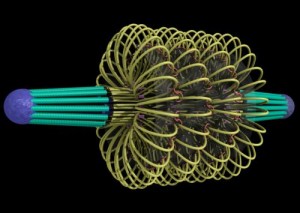 The centriole spindle has been described as the most complex machine known in nature. It orchestrates the dividing of the cell and is made up of nine triplets of microtubules similar to the structure of the base of the PI. Recently, many relationships have been found between the centriole and the PI.
The centriole spindle has been described as the most complex machine known in nature. It orchestrates the dividing of the cell and is made up of nine triplets of microtubules similar to the structure of the base of the PI. Recently, many relationships have been found between the centriole and the PI.
The mitotic spindle isolates and separates chromosomes during cell division. In the human being it consists of 4000 different microtubules with orchestrated movements. It is the most complex process known in biology. It involves many different motors and pumps.
Recently, it was discovered that a membrane made of protein from the PI is placed in a sac and travels with the centriole spindle as a small vesicle when the cell divides. The sac that has the piece from the PI is passed onto one cell and it then has the same molecules to create the exact form and structure of the mother PI in the new cell. Could the PI microtubule structure that is passed on to the next generation have information somehow stored in the microtubules.
Another strange connection is that the same molecules that are at the site upon which cilia microtubules grow are also in the centriole. Both the cilium base and the spindle use the same microtubule structure of nine triplets. The same process of cilia microtubules is part of the process of cell division. Also, receptors from the PI membrane, serotonin and somatostatin, occurs in both.
T Cell Cilium
 Until recently, it was not obvious that lymphocytes have PIs. Now, it has been shown that when T cells form critical synapses with other cells—other T cells for activation, dendritic cells to receive antigens, other immune cells for regulation, and targeted cells for destruction—it is actually a PI variant in the T cell.
Until recently, it was not obvious that lymphocytes have PIs. Now, it has been shown that when T cells form critical synapses with other cells—other T cells for activation, dendritic cells to receive antigens, other immune cells for regulation, and targeted cells for destruction—it is actually a PI variant in the T cell.
The base of the cilium consists of a complex microtubule structure called the microtubule-organizing center, or MTOC (also called a centrosome). This is where microtubules are built. This MTOC becomes the focus of the synapses T cells form with other cells for these critical functions. The same PI transport system is used to transport vesicles during these close encounters with other cells. Vesicles are transported by the cilium transport system to the membrane to kill the targeted cell. The transport system brings special receptors that are recycled during T cell activation. T cells, like PIs, also, use the hedgehog signaling process during activation.
Autophagy and PI
Another critical function in all cells is the pathway of growth and the opposite, cellular self-destruction. The autophagy process is a critical quality control for communities of cells, such as organs. Neurodegenerative disease and cancer are highly connected to cascades that lead to runaway growth at one end and cell self destruction on the other (see post Inverse Relation of Cancer and Brain Disease.)
Signaling from the primary cilium, such as using the Hedgehog pathway, appears to induce autophagy. Autophagy and PIs both utilize the same set of complex molecules. It has been found recently that the PI is necessary for stimulation of autophagy. The autophagy machinery is at the base of the PI. The PI regulates autophagy and the autophagy proteins direct the receptors in the PI. All critical sensory and communicating functions are connected with both the PI and autophagy mechanism.
Is the Primary Cilium a Cell’s Antenna or Its Brain?
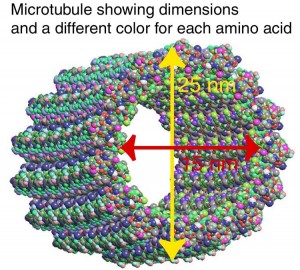 If the primary cilium is the brain of a cell, then it raises the question as to how the critical microtubule structures relate to this. The Penrose-Hammerof theory of the biological basis of mind is based on quantum properties of microtubules. In this theory unique quantum computing processes occur in the exact unusual structure of microtubules. Currently, this theory is unable to be proven, but does provide a speculation as to how the all-important mitotic spindle and the primary cilium might serve as a brain for the cell.
If the primary cilium is the brain of a cell, then it raises the question as to how the critical microtubule structures relate to this. The Penrose-Hammerof theory of the biological basis of mind is based on quantum properties of microtubules. In this theory unique quantum computing processes occur in the exact unusual structure of microtubules. Currently, this theory is unable to be proven, but does provide a speculation as to how the all-important mitotic spindle and the primary cilium might serve as a brain for the cell.
Previous posts have described intelligence in microbes. Microbes swim, communicate, find food, and perform group actions without synapses. All of these sensing and movement behaviors involve microtubules. In the human neuronal synapse, neuroplasticity depends upon the constantly changing microtubule structures. Just like the primary cilium and the mitotic spindle, purposeful complex behavior at many levels appears to involve the microtubules. The extremely complex mitotic spindle in cell division, includes a small sac of the PI material. Is this sac passing on specific information encoded in the microtubule structure for the next generation?
With the primary cilium at the center of cellular sensation, communication, movement, cell division, autophagy and decision making, it is clearly a hub of purposeful behavior in all cells including the neuron. Is it possible that the primary cilium is the brain of the cell?